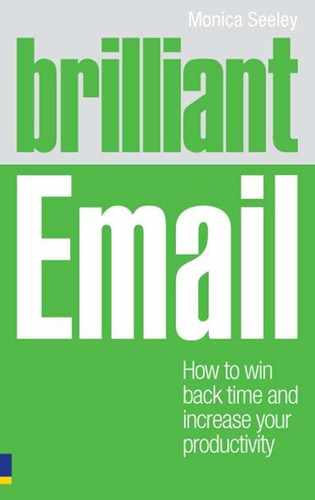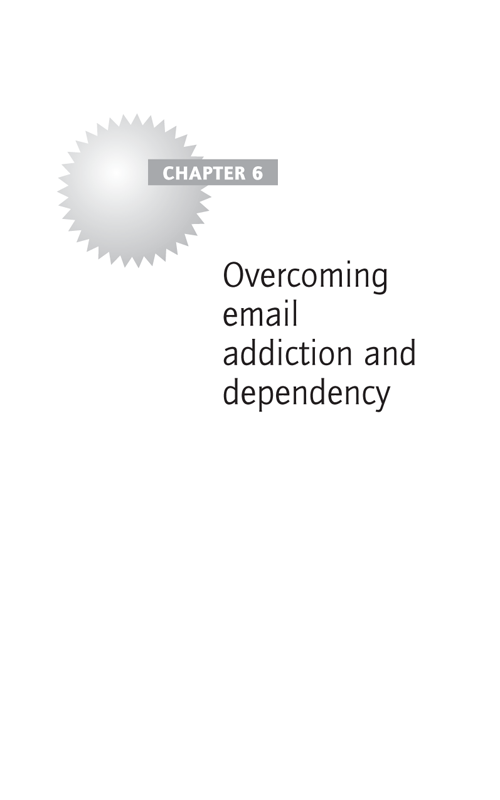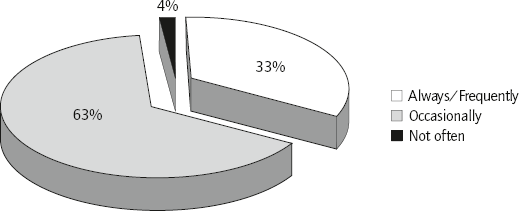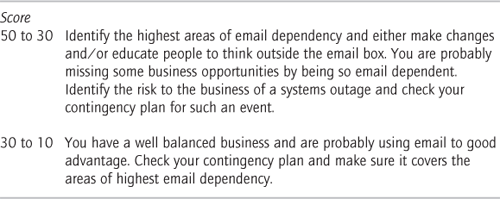Addiction – the state of being enslaved to a habit or practice or to something that is psychologically or physically habit-forming, such as narcotics, to such an extent that its cessation causes severe trauma.
There is a subtle but important difference between email addiction and email dependency. The former is a personal disposition and behaviour, whereas the latter is about the business culture you work in. This chapter covers:
- email addiction and dependency and the costs to individuals and the business
- how to break the cycle and improve your health
- developing a contingency plan for a serious email systems failure (outage) to ensure business continuity.

Email addiction
The constant checking of one’s email for no particular reason.
Addiction – how widespread it is?
There are those who check their emails every few minutes (even in meetings and on holiday) and do not feel they can live without checking. A survey I conducted in 2007 with Revolution Events for their Inbox–Outbox 2007 event found that over 60 per cent of business users check their email when away from the office. When probed, 20 per cent said it was self-inflicted as they perceived it to be expected of them. For more information see www.brilliant-email.com.
Recently a survey carried out by Osterman Research (an Amerian industry market research company) on behalf of the NeverFail Group, found that in the USA 78 per cent of people even checked email while in the bathroom and 11 per cent said they looked at email during ‘intimate moments’. Nearly 80 per cent said they took their mobile devices, which they used to access work email, with them on vacation, and 33 per cent revealed that they hid from family and friends while on vacation just to check email.
Little wonder such devices as the BlackBerry are often called ‘CrackBerries’. The damage they can wreak on your persona and social life can be as bad as taking hard drugs.
The cost of email addiction
As noted in Chapter 3, work-related stress is costly. Professor Cary Cooper, Professor of Organisational Psychology and Health at University of Lancaster, believes email is a major source of employee anxiety, though quite what proportion is hard to quantify exactly. Nonetheless, there is abundant evidence of email stress.
A study for Veritas in 2005 found that one in five people get angry if they can’t immediately access their email. After five minutes a third are ‘irate’. After half an hour another third join the irate gang (and feel like kicking the cat!) and after one hour 82 per cent feel irate and stressed. A week of downtime is thought to be more traumatic than divorce and moving house. In the USA some psychiatrists have now suggested that internet addiction should be treated as a psychiatric disorder.
Email addiction therefore has a cost at both a personal and business level. It also means you are often not taking part in what is currently going on around you because your mind is elsewhere.
Creating a healthier work and social lifestyle by reducing email addiction
I am truly stumped by this technology and the people who are doing it [checking their handheld devices] … You are seated next to Kirk Douglas, Jay Leno, Jane Fonda and Joan Collins and you prefer to hunch over your contraption.
Joan Collins, Spectator, 3 April 2010
Are you suffering from email addiction without realising it? Do you want to reduce the risks of email addiction to your health and work–life balance?

To check your level of email addiction, go to www.brilliant-email.com.
Unlike conventional substance and smoking addictions, there is no medication. Instead, treatment must draw on the ways used to treat alcohol and gambling and adopt a slow withdrawal process.
Here are seven tips to start curing your email addiction and improve your personal wellbeing and relationships, both in and outside work:
- Switch off all the new email notifications and close/minimise your email program.
- Give people an incentive to come and talk to you instead of emailing.
- Tell people you will no longer have your email always open and ask them to call/talk to you if it’s really urgent.
- Limit the number of times you access your inbox (for example, once every 90 minutes).
- Fine yourself if you log in between the set times (and make it painful).
- Celebrate and reward yourself when you reach the target time with no in-between glimpses.
- If you feel you must check your emails on holiday, then either do it once in the evening or towards the end of the vacation.
If you have a handheld email device (BlackBerry, iPhone, etc.), a dramatic measure would be to lock it away and revert to carrying only a dedicated mobile phone.
In addition, you should reduce the volume of email you need to handle as described in Chapters 1 and 2.
![]()
As part of his New Year’s resolutions, Tony Johnson, a senior technical manager, decided to reduce both his own and other colleagues’ email addiction. He offered an incentive (tea/coffee and biscuits) to people who came to talk to him rather than sent an email. The results: fewer emails and more personal networking, as well as a little lost weight as the edibles he gave away were Christmas gifts.
What is email dependency
Email dependency is the perception that everything depends on email and without it no work can be done. Email has come to dominate our lives. Figure 6.1 shows the result of my survey into how often people choose email over other communication methods.
Only a third always think about using an alternative communications channel to email (e.g. phone/face to face discussion). Yet until about 10 years ago email was a rarity for many. Talking face to face or by telephone, pen and paper, fax or typewritten communication were the mainstays of business communication.
Reducing email dependency
Again there is no medication: the cure lies in helping people realise there are alternatives that are just as effective and sometimes more so. Often it takes a crisis of almost epic proportions as illustrated by the example below.
A local authority had a systems outage which lasted for nearly a week. After half a day people started to say they might as well go home as they could not do their work without email. The IT director had to go around and remind people that although they could not send notes and papers by email, they could print them off and either physically take them to their colleagues or use Royal Mail. They could also telephone residents to resolve matters.
Once the systems were re-instated, the IT director decided to implement a set of email best practice guidelines to improve and balance the use of email with other communication methods. They were also designed to reduce the volume of email traffic and size of archive files (which had caused the outage in the first place) and to tackle email dependency throughout the organisation.
The cost of email dependency
In 2005 a report commissioned by CipherTrust (www.ciphertrust.com) estimated that email failures cost UK business £1 billion per year. That’s £68,000 a day based on an average company of 200 employees. Quocirca (www.quocirca.com), in their 2008 report, ‘Soaring not Surfing’, found that, for small- to medium-size businesses, while 25 per cent of businesses said they would lose sales if their system was down for over one hour, the remainder would feel an impact only after a day.
How email dependent is your business?
For how long can you cope without email? What might be the cost to you and your business without it? These are some of the questions you should address using the template in Table 6.1.
Email systems outage
If there was an email systems outage in your business, rate how dependent your business is on email to execute the following tasks/activities. Would you be at risk (and liable for a fine) because you could not process paperwork on time?
Table 6.1 How email dependent is your business?
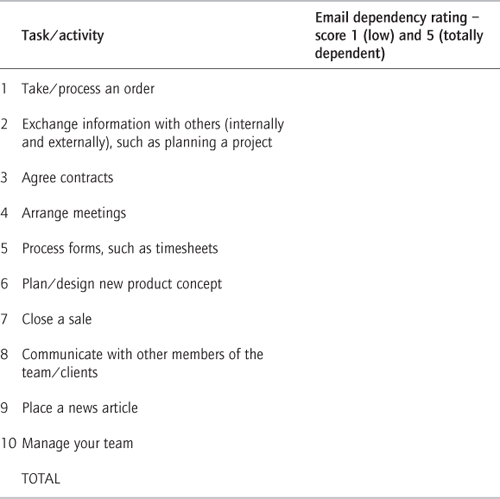
Email is mission-critical for most businesses. As the local authority example discussed on page 84 demonstrates, we might not be able to function at full capacity but most businesses can still operate. The main cost is usually lost orders, especially if you are an e-business. Customers can and will go elsewhere with their order if they cannot get what they want at the first click. However, some people rejoice when there is no email and see it as an opportunity to get their real day job done rather than drowning in email.
Contingency planning for email outages
The key is to have a contingency plan for what would happen if your email was down for more than 24 hours. This might include:
- Switching to an alternative delivery mechanism, such as a USB dongle if the actual network is down.
- Switching to an alternative personal email address (for example, Google or Yahoo).
- Outsourcing to a dedicated email hosting supplier organisation like Mimecast.
- Switching to cloud computing and using a system like Googlemail.
- Making sure you still have a working fax machine.
- Talking.
- Educating employees to be creative and use other techniques.

Make sure you have a contingency plan for email outages that encompasses operations at both the personal and business level.
The plan will need to take account of where the fault lies, whether it’s the server (the most common cause) or the network (broadband, Ethernet, etc.). For a good review of email contingency planning see Mimecast’s white paper ‘Email as Part of a Business Continuity Strategy’ (www.mimecast.com).
Breaking the email dependency cycle
To help the business reduce its email dependency you need to educate your employees to remain calm and be productive without email. Ways to achieve this include training and occasional email-free periods. It’s like testing the fire alarm and evacuating the building in the event of a disaster: you hope it will not happen, but you must be prepared.
Email-free periods
Many companies have email-free periods to reinforce the message that email is not the only way. At Intel on Fridays, for instance, their engineers try to deal with all problems just by talking.
Deloitte ran an email-free campaign for a short while to reinforce the message that sometimes it was more expedient to talk than email. Although they have since dropped the campaign, they say that it achieved the desired effect.
- Reducing personal email addiction can improve your health and well being.
- If you are suffering from email addiction start by limiting the number of times you access your emails. Let everyone know and ask for their support.
- Leave behind or lock away your mobile email device when on holiday.
- Limit any financial consequences of an email outage by making sure you have a robust contingency plan in place.
- Educate people that email is not the only way and that there is life without email.
- Reviewing and reducing your business email dependency will ensure the business continues to function, and limit the disruption in the event of a systems outage.
- Changing your organisation’s level of email dependency may highlight more cost-effective and competitive ways to do business (for example, sometimes a sale can be closed more quickly with a conversation than by email).
